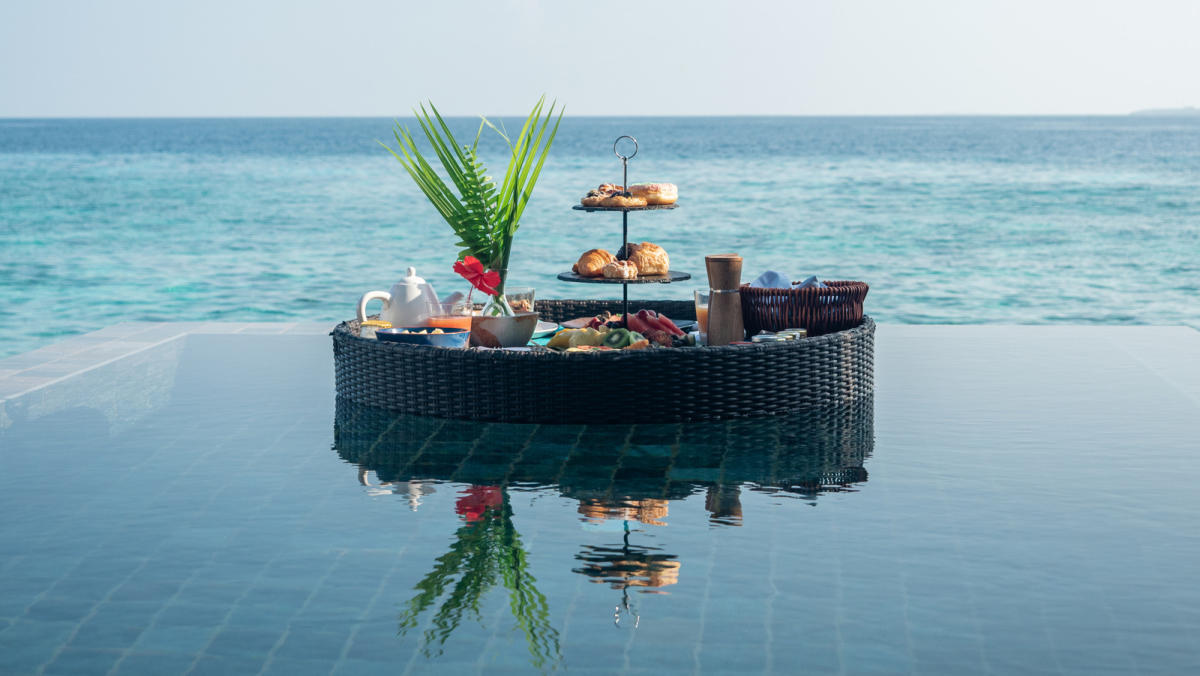You’ve seen it before. A video pans from a breathtaking backdrop and pristine swimming pool to a plate of eggs. The whole experience is like a combination between breakfast in bed, a swim-up bar, and a floating lounge chair. But when did breakfast served à la raft become a thing, and why do people love it?
It appears that this trend emerged in Bali, Indonesia. Specifically, a 2016 press release from the Bali branch of the Ritz-Carlton hotel detailed a luxury, customizable villa experience that included a floating breakfast as one of the amenities. This seems to be one of the first times the trend was directly referenced in writing. When you think about it, it appeals to many aspects of what people tend to like — dining al fresco, being in the water, a beautiful view, and exclusive experiences.
Indeed, it is that exclusivity that is a big part of what made the floating breakfast trend catch on. Colorful fruits, aethetically arranged plates, fresh flowers, and beverages with beautiful latte art expertly presented in a luxurious locale makes for an eye-catching Instagram post, to be sure. A meal enjoyed from the inside of a pool is not an experience easily had at a public spot. Enjoying (and posting) about a floating breakfast makes it known to everyone that the poster is the type of person that indulges in private stays. Additionally, as traveling changed to adapt to the Covid-19 pandemic, socially distanced vacations grew in popularity, and a breakfast spread delivered directly to your villa certainly fit the bill.
Read more: 14 Never-Ending Food Debates
Drawbacks Of The Floating Breakfast Trend
Not all that glitters is gold. Though you probably will not see this reflected in the thousands upon thousands of social media posts, there are definitely some drawbacks to having your first meal of the day served this way. Depending on the structure of the pool, you may be chest deep as you try and take a bite of your bagel. Any dishes that require a fork and knife like a classic eggs Benedict may also require you to grow a third arm or enlist the help of your dining companion to hold the raft in place while you cut.
Additionally, grimy pool water can easily drip into your freshly squeezed juice or soak your pastries, and your wet hands are now covered in bacteria. Proper treatment of pools still does not make that water safe to consume. Even if you do manage to find a comfortable spot to sit or stand and keep the whole set-up sanitary, you still run the risk of knocking the entire raft over.
Make The Floating Breakfast Trend Work For You
Despite some inherent inconveniences, these Instagrammable meals are here to stay, with resorts and travel sites featuring a wide variety of options. Whether you’re checking an item off your bucket list or simply just curious, there’s a way for you to get in on this trend. While more accessible breakfasts can be as little as $25, the price tag tends to fall in the $70 to $90 range, with the most expensive options reaching up to $200. Pick an experience that fits your budget. However, if wrangling a floating tray when you are bleary-eyed and desperately in need of coffee doesn’t sound like your idea of elevating your breakfast, opt for a floating lunch, afternoon tea, or evening cocktails and appetizers instead.
Before you do spend the money, it’s also a good idea to test out your pool to see if it will actually be comfortable. You do not want to be standing on your tippy toes for a whole meal, so a pool that has a built-in seat or shallow water is your best bet.
Pay attention to the timing, and position your tripod before the food arrives, so you can get that ever-important photo as quickly as possible. Otherwise, your food could get cold and soggy. Or, opt for a spread that can still be enjoyed at room temperature. It is also a good idea to have a small towel and hand sanitizer ready, so you can dry off and clean up before you dig in.
Want more food knowledge? Sign up to our free newsletter where we’re helping thousands of foodies, like you, become culinary masters, one email at a time.
Read the original article on Food Republic.
